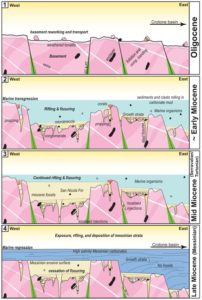BOOKINGS CLOSE AT 17.00 ON 20 APRIL 2021!
20th April 2021
Event phone:
Abstract
Speaker: Bob Holdsworth – Durham University
Geological fissures: a neglected structural phenomenon and the key to understanding how fractured basement reservoirs work
R.E. Holdsworth1, K. Hardman2, R.J. Walker3, A. Bubeck4, C. Greenfield3, J.K Lee1 & K.J.W. McCaffrey1
1 Department of Earth Sciences, Durham University and Geospatial Research Ltd, Durham
2 Energy and Environent Institute, Hull University
3 School of Geography, Geology, and the Environment, University of Leicester
4 Lettis Consultants International, Concord, California
Dilatant fissures are a common feature at the Earth’s surface, in active rift systems where faults cut mechanically-strong rocks, such as igneous rocks, metamorphic basement or carbonates. Much attention has focused to date on modern examples of large-aperture fissures in basaltic rocks, where in most cases, only the near-surface-expression is accessible to depths of ~100 m. Numerous mechanisms have been proposed for the formation of such dilatant fractures, including near-surface tensile fracturing along active normal faults at depth, geometric mismatch along faults, and fault-block rotation. However, fissure system architecture and connectivity in the subsurface and the depth to which dilatant sections can grow is less well understood. Furthermore, the potential for geologically long-lived maintenance of such voids – including at depth – is greatly underestimated.
Using ancient examples from onshore-offshore UK and southern Italy, we focus on the nature and development of dilatant faults and fractures hosted in basement rocks below regional erosional unconformities, commonly on the upfaulted flanks of nearby sedimentary basins. Such fissures are typically sub-vertical Mode I fractures that can be kilometres long, tens of metres wide and can extend to depths of 1 km or more below the palaeosurface. They are filled with a remarkably diverse range of high porosity, high permeability fills which act as natural proppants holding fractures open for tens to hundreds of million years. Fills include wall rock collapse breccias, clastic sediment, fossiliferous materials, and a variety of epithermal mineral deposits with characteristically vuggy forms and cockade textures. Surface weathering and alteration related to near surface epithermal mineralization may extend down fissure systems to depths of many hundreds of metres. The subterranean clastic fills are commonly water-lain and preserve a unique record of the stratigraphic or fossil record that may be missing due to erosion at the overlying unconformity. Fissures can form along active normal faults at depth, as later-stage reactivations of pre-existing exhumed fault zones and along regional joint sets associated with folds. Some fissures form along the margins or interior of pre-existing mafic dykes or may act as sites of subsequent dyke emplacement – or both. Sub-unconformity fissure systems and their associated fills are almost certainly a major influence on both the fluid storage capacity and flow behaviour in subsurface reservoirs including those hosting hydrocarbons, geothermal resources, and in aquifers worldwide.

Fissure system evolution in fractured basement, Calabria, Southern Italy
Sponsor
This event is kindly hosted by:

Venue Information
Venue information
Venue name:
Online
Venue address:
This event will be delivered online.

